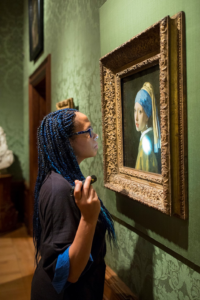
Please tell us a little about the “Girl in the Spotlight” project.
In 2018, a group of researchers carried out a technical examination of Johannes Vermeer’s Girl with a Pearl Earring. We wanted to find out as much as we could about the materials and techniques that Vermeer used to paint this masterpiece.
Because the Girl is the most beloved painting in the collection of the Mauritshuis, The Hague, Netherlands, the examination took place in front of the museum public over a two-week period.
The collection in Heritage Science reports the results of this study.
This isn’t the first time that the Girl has been studied in this way. How does your project build on its predecessor?

In 1994, the painting was restored and examined—also in front of the museum public—as part of the project “Vermeer Illuminated”. The scientists and conservators made many fascinating discoveries: for example, that the background of the painting was originally dark green.
Over the past 25 years, the analytical and imaging techniques we have at our disposal have improved in accuracy and resolution, and more importantly, non-invasive techniques have been developed. This meant that we barely needed to touch the painting as part of our “Girl in the Spotlight” examination.
Your paper serves as an introduction to the collection and focuses on the approaches and methodologies for re-examining the painting. What were the primary techniques involved?
We used non-invasive techniques that mapped, scanned, imaged and magnified the painting and its materials: computer-assisted thread-level canvas analysis, fiberoptic reflectance spectroscopy, fluorescence imaging spectroscopy, 3D color/gloss scanning, high-resolution 3D digital microscopy, macroscopic X-ray fluorescence, macroscopic X-ray powder diffraction, multi-scale optical coherence tomography, multispectral infrared reflectography, reflectance imaging spectroscopy, microscopy, X-radiography, and technical photography.
To fit all of these methods into a two-week period took precise timing and cooperation.
We re-analyzed microscopic paint samples that were taken in 1994, but fortunately that could be done before and after the examination in front of the public.
What is it about Girl with a Pearl Earring that you think means she has such enduring affection from the general public, even 350 years after Vermeer painted her?

Different people have different reasons to engage with the Girl. The composition is deceptively simple, and inspires the viewer to wonder: Is she turning towards me or away from me? Is she wearing a real pearl? Is she a portrait of a specific person, or a tronie (character study)?
The questions we answered as part of “The Girl in the Spotlight” were more technical in nature. What steps did Vermeer take to create the painting? What can we find out about layers beneath the surface? Which materials did Vermeer use and where did they come from? Which techniques did Vermeer use to create subtle optical effects? What did the painting look like originally, and how has it changed?
We hope that our findings will inspire even more public interest in the Girl, especially into Vermeer’s materials and techniques.
—
Abbie’s paper is the first article in an exciting new collection in Heritage Science. Be sure to check back regularly as new papers are published.
The project “The Girl in the Spotlight” is a Mauritshuis initiative, and involves a team of internationally recognized specialists working within the collaborative framework of the Netherlands Institute for Conservation+Art+Science+ (NICAS), with some scientists from other institutions, including University of Antwerp and the National Gallery of Art, Washington DC.
Comments